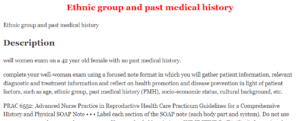Ethnic group and past medical history
Ethnic group and past medical history
Ethnic group and past medical history
Description
well women exam on a 42 year old female with no past medical history.
complete your well-woman exam using a focused note format in which you will gather patient information, relevant diagnostic and treatment information and reflect on health promotion and disease prevention in light of patient factors, such as age, ethnic group, past medical history (PMH), socio-economic status, cultural background, etc.
PRAC 6552: Advanced Nurse Practice in Reproductive Health Care Practicum Guidelines for a Comprehensive History and Physical SOAP Note • • • Label each section of the SOAP note (each body part and system). Do not use unnecessary words or complete sentences. Use standard abbreviations. SUBJECTIVE DATA (S): (information the patient/caregiver tells you) Includes all of the information the patient tells you. Identifying data: Initials, age, race, gender, marital status. Name of informant, if not patient. CHIEF COMPLAINT (CC): The reason for this health care visit. A statement describing the symptom(s), problem, condition, diagnosis, physician-recommended return, or other factors that are the reason for this patient visit (even if they bring no specific problem). If possible, use the patient’s own words in quotation marks. HISTORY OF PRESENT ILLNESS (HPI):
If the patient presents with specific problems, symptoms, or complaints, a chronological description of the development of the patient’s present illness from the first sign of each symptom to the current visit is recorded using the elements of a symptom analysis. Those elements are: • Location: Where it started, where it is located now • Quality: Unique properties or characteristics of the symptom • Severity: Intensity, quantity, or impact on life activities; duration: length of episode • Timing: When symptom started, frequency (patient’s “story” of the symptom), context (under what conditions it occurs) • Setting: Under what conditions the symptoms occur, activities that produce the symptoms • Alleviating and aggravating factors: What makes it better and/or worse, what meds have been taken to relieve symptoms, did the meds help or not, does food make symptoms worse or better • Associated signs and symptoms: Presence or absence of other symptoms or problems occurring with their complaint; include pertinent negatives and information from the patient’s charts (e.g., lab data or previous visit information) In the case of a well visit, describe the patient’s usual health and summarize health maintenance needs and activities. PAST MEDICAL HISTORY (PMH): Allergies Current medications: prescription and over the counter © 2021 Walden University PRAC 6552: Advanced Nurse Practice in Reproductive Health Care Practicum Age/health status Appropriate immunization status Previous screening tests result Dates of illnesses during childhood (may not be very important in adults; exceptions may include rheumatic fever or chronic illnesses continuing into adulthood) Major adult illnesses (include history of diabetes, hypertension, gastrointestinal diseases, pulmonary disease, cardiovascular disease, cancer, tuberculosis, sexually transmitted infections (STIs), HIV/AIDS, gynecological or urological problems, drug and/or alcohol abuse, and psychiatric illness) Injuries Hospitalizations (reason, hospital, attending physician [if known]) Surgeries (include hospital and year) FAMILY HISTORY (FH): Age and current health status or age at death and cause of death of each family member (parents, siblings, and children) is recorded. Occurrence within the family of illnesses of an environmental, genetic, or familial nature are recorded in family history. Ask about the presence in the family of any of the following conditions: asthma, glaucoma, myocardial infarctions, heart failure, hypertension, cancer, tuberculosis, diabetes, kidney disease, hemophilia, sickle cell trait or disease, psychiatric diseases, alcoholism allergies, family violence, mental retardation, epilepsy, and congenital abnormalities. Record any specific diseases related to problems identified in CC, HPI, or review of symptoms (ROS). SOCIAL HISTORY (SH): Record important life events: marital status, occupational history, military service, level of education. Record lifestyle and current health habits (may be here or in ROS): exercise, diet, safety (smoke alarms, seatbelts, firearms, sports), living arrangements, hobbies, travel. Record religious preference relevant to health, illness, or treatment. Record habits: use of drugs, alcohol, and tobacco. Resources: resources to pay for care, insurance, worries about cost of care, history of postponing care. Reproductive Hx: Menstrual history (date of last menstrual period [LMP]), pregnant (gravida and Parity), nursing/lactating (yes or no), contraceptive use (method used), types of intercourse (oral, anal, vaginal, other), gender sexual preference, and any sexual concerns. REVIEW OF SYSTEMS (ROS): There are 14 systems for review. Record a summary for each system. Unexpected or positive findings need complete symptom analysis. © 2021 Walden University PRAC 6552: Advanced Nurse Practice in Reproductive Health Care Practicum 1) Constitutional symptoms: Overall health, weight gain or loss, ideal weight, fever, fatigue, repeated infections, ability to carry out activities of daily living. 2) Eyes: eye care, poor eyesight, double or blurred vision, use of corrective lenses or medications, redness, excessive tearing, pain, trauma, date and results of last vision screening or eye exam 3) Ears, nose, mouth, and throat: Ears: hearing acuity, exposure to high noise level, tinnitus, and presence of infection or pain, vertigo, use of assistive hearing device. Nose: sense of smell, discharge, obstruction, epistaxis, sinus trouble. Mouth and teeth: use of oral tobacco or smoking cigarettes, last dental exam date and result, pattern of brushing and use of dental floss and fluoride toothpaste, dentures, bleeding of gums, sense of taste, mouth odor or ulcers, sore tongue. Throat: sore throat, hoarseness, dysphagia. 4) Cardiovascular: Exercise pattern to maintain cardiovascular health. History of abnormal heart sounds (including murmur), chest pains, palpitations, dyspnea, activity intolerance, usual blood pressure, ECG (date, reason), cholesterol level (date), edema, claudication, varicose veins. 5) Respiratory: Exposure to passive smoke. History of respiratory infections, usual self-treatment, cough, last chest x-ray (date, result), exposure to tuberculosis (TB) and last TB skin test (date and result), difficult breathing, wheezing, hemoptysis, sputum production (character, amount), night sweats. 6) Gastrointestinal: Dietary pattern, fiber and fat in diet, use of nutritional supplements (vitamins, herbs), heartburn, epigastric pain, abdominal pain, nausea and vomiting, food intolerance, flatulence, diarrhea, constipation, usual bowel pattern, change in stools, hemorrhoids, jaundice. 7) Genitourinary: Nocturia, dysuria, incontinence, sexual practices, sexual difficulty, venereal disease, history of stones. Men: slow stream, penile discharge, contraceptive use, self-testicular exam. Women: onset, regularity, dysmenorrhea, intermenstrual discharge or bleeding, pregnancy history (number, miscarriages, abortions, duration of pregnancy, type of delivery, complications), menopause (if present, use of hormone replacement therapy), last menstrual period (LMP), contraceptive use, last pap smear (date and result), intake of folic acid. 8) Musculoskeletal: Exercise pattern, use of seatbelts, use of safety equipment with sports, neck pain or stiffness, joint pain or swelling, incapacitating back pain, paralysis, deformities, changes in range of motion of activity, screening for osteoporosis, knowledge of back injury/pain prevention. 9) Integumentary (skin and/or breast): Use of skin protection with sun exposure, self-examination practices in assessing skin, general skin condition and care, changes in skin, rash, itching, nail deformity, hair loss, moles, open areas, bruising. Breast: practice of self-breast exam, lumps, pain, discharge, dimpling, last mammogram (date and result). 10) Neurologic: Muscle weakness, syncope, stroke, seizures, paresthesia, involuntary movements or tremors, loss of memory, severe headaches. 11) Psychiatric: Nightmares, mood changes, depression, anxiety, nervousness, insomnia, suicidal thoughts, potential for exposure to violence. © 2021 Walden University PRAC 6552: Advanced Nurse Practice in Reproductive Health Care Practicum 12) Endocrine: Thyroid problems, cold or heat intolerance, polydipsia, polyphagia, polyuria, changes in skin, hair or nail texture, unexplained weight change, changes in facial or body hair, change in hat or glove size, use of hormonal therapy. 13) Hematologic/lymphatic: Bruising, unusual bleeding, fatigue, history of anemia, last HCT and result, history of blood transfusions, swollen and/or tender glands. 14) Allergic/immunologic: Seasonal allergies, previous allergy testing, potential for exposure to blood and body fluids, immunized for hepatitis B, immunosuppression in self or family member, use of steroids. OBJECTIVE DATA: A concise report of physical exam findings. Systems (there are 12 systems for examination): 1. Constitutional (VS: Temp, BP, pulse, height and weight); a statement describing the patient’s general appearance 2. Eyes 3. Ear, nose, throat 4. Cardiovascular 5. Respiratory 6. Gastrointestinal 7. Genitourinary 8. Musculoskeletal 9. Integument/lymphatic pertaining to each location 10. Neurologic 11. Psychiatric 12. Hematologic/immunologic Results of any diagnostic testing available during patient visit. ASSESSMENT (A): List and number the possible diagnoses (problems) you have identified. These diagnoses are the conclusions you have drawn from the subjective and objective data. Diagnosis must be codable (CPT codes). Provide adequate information to justify ordering additional data (e.g., lab, x-ray). Do not write that a diagnosis is to be “ruled out.” State the working definitions (symptoms, probable diagnoses) of patient problems in the following areas: o Health maintenance o Acute self-limited problems o Chronic health problems In cases where the diagnosis is already established, indicate whether the diagnosis has the following characteristics: improved, well controlled, resolving, resolved, inadequately controlled, worsening or failing to change as expected. © 2021 Walden University PRAC 6552: Advanced Nurse Practice in Reproductive Health Care Practicum Note: Inadequately controlled chronic conditions should have a possible etiology written (e.g., exacerbation, progression, side effects of treatment) if known. PLAN (P): (The plan should be discussed with and agreed on by the patient.) The treatment plan includes a wide range of management actions: Laboratory test Consultation requested and justification Medications prescribed (name, dose, route, amount, refills) Appliances prescribed Lifestyle modifications: diet, activity modification Patient education and patient responsibilities (e.g., keeping food diary or BP record) Patient counseling related to lab/diagnostic results, impression, or recommendations Family education Details concerning coordination of care: arranging and organizing patient’s care with other providers and agencies Follow-up should be specified with time (in days, weeks, months) and/or circumstances of return or noted as PRN Note: Number the plan to correlate with the problem list in the Assessment. © 2021 Walden University
Use the following coupon code :
NursesHomework


